This article has been written by Adeendren Iyan of petfriendlydirect.com.

Yes, cats are independent creatures and can be stubborn at times. Although, much like human behavior, they are also socially flexible. If given the opportunity and the appropriate training, cats can develop a solid and lasting bond with their owners. Besides playtime or fun, cats can also use their training to overcome behavioral issues such as urine marking, aggression, furniture scratching, etc. The act of training cats allows parents to spend more time stimulating their pet’s mind and body, keeping both parties engaged, motivated, and healthy.
Despite the widespread belief that cats cannot get trained, it’s up to the owners to understand what incentivizes or drives their furry friends. Teaching your cat new tricks is based on trial and error, depending on their personality, traits, temperament, and preferences. Unlike dogs who want to impress their owners, cats prefer to be given something in return for their efforts. Owners must keep in mind that even though cats are highly intuitive and alert, they can take time to respond with willingness. The parent’s job is to train with patience, empathy, and respect for their cat’s personal space. While teaching new tricks and bonding with the cat is suitable for their health, it’s equally important to provide them with the best flea treatment. Another great way to save money and time is to subscribe to monthly flea treatment for your cat, avoiding the hassle of making regular trips to the vet.
When training your cat, there are a few things to keep in mind to help you interact more efficiently:
- Using noise-making devices, such as clickers, can help the cat mark their good behavior and connect the sound with the following treat.
- Using positive reinforcements (rewards) such as your cat’s favorite treats, catnip, petting, etc., can reinforce the desired behavior and help them respond faster due to increased motivation.
- A hungry cat is the most eager learner since they want to be rewarded with food instantly. However, the trick is to keep the training sessions crisp and short; otherwise, they might lose interest.
- Cats are a creature of habit and have a better memory than other animals. We recommend maintaining consistency while training and keeping short spurts of sessions, i.e., less than 10 minutes.
- Punishing your cat can cause severe stress and anxiety, damaging the bond you share and causing a breach of trust.
Trick 1: Fist Bump

One of the most popular ways to showcase your bond with your feline friend is through a fist bump. It may not look easy initially, but it is pretty achievable with the right conduct. It would be best to understand that no two cats are the same, and some of them will take time to learn and get used to the commands. So, you can start by offering your cat a small treat in a narrow bowl so that he/she uses her paw to get the treat out. As soon as she does, say “Yes.” Next time, repeat this while holding the cup a little higher in your hand. Slowly, get away with the bowl and replace it with your fist. Be patient and always reward your cat with a treat when she follows through.
Trick 2: Use a Harness

Cat owners believe that having their pets indoors can be a safe option for them. While this is true, cats require stimulation by exploring the outdoor environment, spending quality time with their owners, and experiencing different sights, sounds, and smells.
Firstly, find a harness that secures your cat to a tee so that they aren’t able to wiggle out and escape into the woods. Then, introduce your cat and allow it to get accustomed to wearing the harness around the house. You can also place a few treats near the harness to pique your cat’s interest. When they seem comfortable, begin by taking your cat to the balcony or terrace area. Keep some treats ready in hand to offer if they’re stressed, and allow them to walk at their own pace, taking in the new environment.
Only when you know that they’ve adapted to the outdoor space, can you take them to roam around your neighborhood, explore the gardens, etc.
Trick 3: Board the Carrier

Using a carrier is essential for a cat parent during different events, such as visiting a veterinarian, going for a trip, switching homes, etc. While the general behavior of cats towards carriers is unpleasant, there is a way for owners to change this around.
The first step is to find a carrier made of the right material, size, and with proper ventilation. A detachable top is a bonus so that you won’t have to force your cat to exit each time. The best way to start is by keeping the carrier in a separate room, with no loud sounds or distractions. Then lay a mat next to an open carrier and place some treats over it for your cat to nibble on. It will take a few days for your cat to move closer and closer to the carrier before they step inside for the treats. Also, remember that any harsh noise such as banging the door, roughly placing the cat inside, or any background movement can stress out your cat. Instead, relax your cat and allow them to take their time to lay on the mat inside the carrier. Then start by closing the door gently, in small degrees, until they begin to feel more and more relaxed inside. You can occasionally place a few toys, along with favorite treats, to allow your cat to feel secure, even when you’re not in the room.
Gradually, you can start by transporting them from one room to another before you take them for their annual checkups or other travels.
Trick 4: Jump Through an Arm Hoop

Apart from looking cool, an arm hoop jump is an excellent way to keep your cat active. Although it may look tricky at first, once you get the basics right, you’ll notice that your feline friend seems to be having a lot of fun. Reward training is an excellent place to start, and having a treat at the finishing end will motivate your cat to follow through. The other thing to consider is getting the right kind of hoop. A noisy or unstructured hoop might distract the cat. Moreover, it’s better to let your cat explore the hoop while introducing it to her. The more familiar it becomes, the more comfortable your cat would feel around it. Then by practicing it more and more and with targeted training, your cat will get in the groove and start liking it quite a lot.

In conclusion, training a cat can be challenging at times, but cat owners must remember that patience and repetition will help with even the most distant felines. While most parents start training cats at a young age, when they’re most adaptive and involved, older cats can also get trained as long as they’re consistent and patient. The end goal is to reinforce your cat’s good behavior and help deepen the bond between you and your feline friend.
* This blog is designed to be a community where pet owners can learn and share. The views expressed in each post are the opinion of the author and not necessarily endorsed by Pawjourr. Always consult your veterinarian for professional advice.
